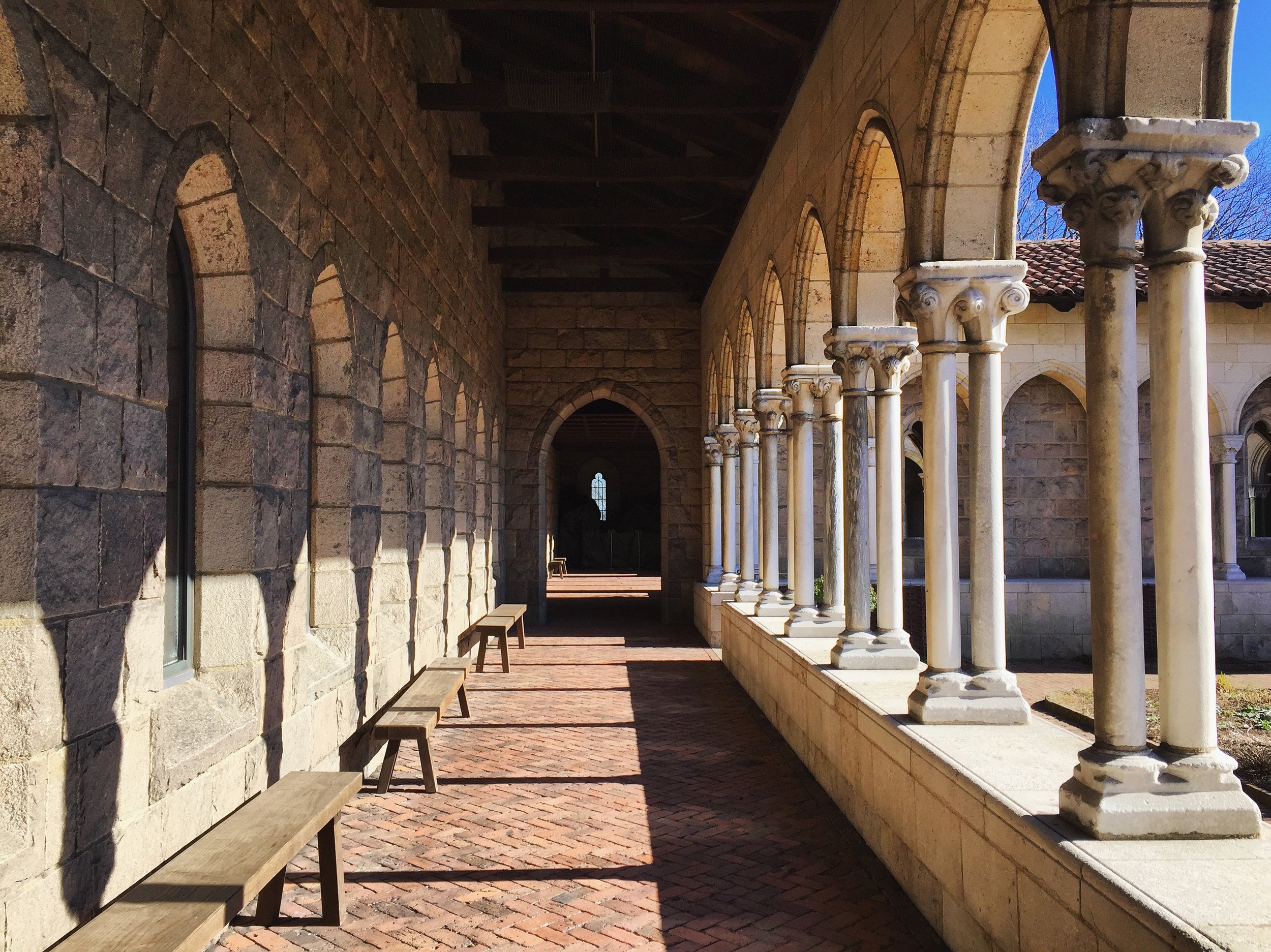Of cloisters, unicorns and profiteering

A recollection of our visit to the Met Cloisters, stumbling upon medieval chapels, cloisters, unicorn tapestries and a question of acquisition.
I have always been a museum buff. So it comes as no surprise that one of my favorite places in New York City is the Metropolitan Museum of Art (lovingly called the Met by locals) at 5th Avenue. Through my visits I was aware that the Met has two other branches around the city. One is called the Met Breuer which houses the Met's more modern and contemporary exhibition and the Met Cloisters which is located in Fort Tyron Park in a purpose built building focusing on Medieval art and architecture.
The Met Cloisters is located quite far away from the hustle and bustle of Midtown Manhattan everyone seem to identify New York with. It's located in the area of Washington Heights, North Manhattan with the closest subway station being the 190th street station . The remote location was the main reason I've never managed to muster enough willpower to make the required trip. Though as Benoit was visiting and after having our interests piqued from catching a glimpse of the castle-like building that houses the museum from the Hudson River, we decided to make our way there one crisp winter morning.
To get to the Cloisters from the station you'd have to cross Fort Tyron Park. The museum itself is located in the heart of the park and on top of a hill overlooking the Hudson and Upper Manhattan. Apparently John D. Rockefeller Jr., who commissioned and built the museum, also bought a few hundred acres of the land opposite the Hudson river in New Jersey to preserve the view from the Museum. That land is now part of the Palisades Interstate Park where we hiked last autumn. Fort Tyron Park itself was very beautiful even with all the dead and leafless trees creating a more Tim Burton-esque feel to it. We made our way through the park under the clear blue sky and with the morning winter sun shining brightly upon us.
After about 10 minutes walk we spotted the museum itself. The first thing that we noticed was the tower, which really reminded me of a tower from a medieval monastery. As we got closer, even from the outside, we started noticing how the museum itself was built in the shape of medieval buildings; a distinctly gothic chapel seem to jut out on the building's south side and we caught glimpses of both Gothic and Romanesque arches which adorn the walkways and courtyards of the building, a slight teaser of what was to come next.
Entering the museum we were told that a free gallery talk/tour have just started, so we quickly made our way to one of the chapels in the museum. Even by just walking past the museum, we could tell that this particular museum experience was going to be quite special. Glancing around the museum, we noticed the lack of crowds that usually marks any New York museum on a Saturday morning. We believed that due to the distance from Midtown, not many tourists made their way up here to the Cloisters. Enjoying the rather quiet atmosphere and after walking through an ornately decorated gate, we found ourselves in a small reconstructed 12th century French Chapel.
After meeting our guide, as an introduction to the museum, she recounted a short history of the museum which involved a man called George Grey Barnard, an American sculptor and Art collector who first collected the pieces that would form the nucleus of the museum's collection. The collection was then bought by Rockefeller who expanded it and constructed the museum as it stands today.
Our guide for the day was a historian who focuses on ancient and medieval architecture. Her enthusiasm and passion for the subject was very palpable from the start when she was explaining to us about the continuation of architectural styles and method from the Roman period to the Middle Ages. At one point she pointed to a section of the wall which was part the original stone wall of the chapel and told us that no one would ever bat an eye seeing those stones, but for her it's a constant source of wonder and excitement. The reason is because the way the stone was cut showed a continuation from ancient Roman stone cutting techniques to the Middle Ages.
How the technique was passed down throughout the centuries is not yet certain. She told us that it might be that some quarries were still functioning throughout the period, ensuring the technique was not lost; or it could also be that its a rediscovery of the techniques used by ancient Romans by the people of the Middle Ages. We found that it was a really interesting insight and definitely something struck me as quite an interesting moment. Who could ever thought that a plain old stone in a wall could hold such interest and inspire such wonder and excitement in someone?
We then weaved our way through the many ornate corridors of the museum, visiting a gloriously reconstructed chapel from 12th century Spain and across the various cloisters that was also reconstructed throughout the museum. As we were going through the different chapels and cloisters, we can't help but feel like we were being teleported across time and space every time we walked into a different section of the museum. They reconstructed most of the original architectural elements of all the chapels and cloisters. In doing so, they have recreated the space where the art works were originally placed and gave us a very strong context of how the artworks were seen and used in their original state. As I have written before about the National Museum of Anthropology of Mexico, I love museums that tries to put the artifacts into context rather than just treating them as mere objects to be showcased in a cold exhibition room. Although the cloisters did not go as far as the National Museum of Anthropology in Mexico City, as they did not provide us with a snapshot of the day to day life of the monks who used to inhabit these spaces, they still did an astounding job at recreating the feel and context on which the artworks were created and meant to be viewed.
One of the highlights for us was the Cuxa Cloister from the Benedictine monastery of Saint-Michel-de-Cuxa, Mount Canigou in the northeast French Pyrenees, founded in 878. The monastery was abandoned in the 12th century and after falling into abandonment and disrepair, it was purchased by Barnard and moved to New York. The carvings on the pillars were both grotesque and beautiful at the same time and the they were all carved on a beautiful creamy pink marble native to that region. When in the reconstructed cloister, it was actually quite difficult to differentiate the new stones installed during reconstruction with the original stones. Our guide explained to us that the reason for this is because, when reconstructing the cloister, they actually opened the original quarry where they mined the stones the monks used to build the original monastery.
The museum also has a treasury located in its lower level, right by some reconstructed Cloisters and a beautiful medieval style garden overlooking the Hudson River. The treasury contained some of the museum's most precious objects including rare wood carvings, gorgeous illuminated manuscripts, jewel encrusted reliquaries and delicately carved statues made out of Walrus ivory. A statue in particular, depicting a crucified Christ, caught my eye due to the sensitivity and beauty of its depiction of something that is so sorrowful.
Another highlight of the museum for me was the Unicorn Room. The room itself does not seem like much, but on the walls of the room were incredibly beautiful tapestries depicting mystical scenes of the hunt and capture of a Unicorn. There was also an added touch of displaying a Narwhal tusk, which bear some resemblance to a Unicorn's horn, at one corner of the room. In true medieval style, some elements of the tapestries were rather violent and grotesque. But the overall effect was still stunning. Reading the guide, we found out that the series of tapestries dates from late 15th to early 16th Century and was probably woven in Brussels or Liege. The tapestries showed both a mixture of Pagan and Christian symbol and in my opinion was just an absolute joy to look at and admire. This, coupled with the setting, really made us feel like we were in Europe, exploring some medieval castle or mansion, rather than in the middle of a park in New York City. Our visit to the museum really felt like going through some form of a Medieval Disneyland, with the different rooms of the museum acting as different 'rides' or experiences. Truly a gem of a museum.
At the end of the tour and after the customary round of applause, the guide asked if anyone had any further questions to ask about the museum. One person raised his hand, and asked if it was true that the reason why Barnard was able to amass such a beautiful collection was because the country of origin of the respective artifacts did not value them in the first place. He then recounted a story he heard about how some of the beautiful medieval statues currently in the museum collection were once found in gardens or barns and was completely neglected and left to rot. Our guide nodded politely throughout the exchange and when he finished seemed to take note of something in her mind. She then began explaining to us that from what she know, some of those stories might be true. But, she also cautioned us to take stories like this with a grain of salt. Most of the collection were amassed in the period during and just after World War I. Therefore there were a lot of confusion and destruction during the period, in which an unscrupulous art dealer could really take advantage of. Ultimately stories like the ones the man recounted are very self-serving stories, usually created by people like Barnard to justify their acquisition of what is essentially another cultures' heritage and treasures.
This sort of reminded me of the debate about the Elgin Marbles and how Lord Elgin argued that he took the sculptures from the Parthenon out of concern of its state of preservation. Whether this is true or not is anybody's guess. I personally suspect that there is definitely that element of 'wanting to preserve or safe the artifacts' forming part of the reason why characters like Barnard or Elgin took those artifacts and treasures out their home countries. But there's always the thought that it might also contain an element of profiteering. Taking advantage of a particularly unstable country or a country who have yet to realize the value of their own heritage and treasures.
After spending almost two hours in the museum, we felt that we have seen most of the collection and decided to leave and catch out lunch reservation. Braving the biting cold of winter air outside, it really felt like I have just stepped into a different world in that museum. One that was filled with cut stones, medieval monasteries, gargoyles and unicorns.
A twenty-something trainee solicitor currently based in New York City. I created this blog with the intention to both record and share my thoughts and experiences relating to the things I love most in life, which is arts and culture, food and traveling. I was born and raised in Indonesia, but have lived abroad since I was 15, first in Singapore, then Nottingham, London and now New York City.














